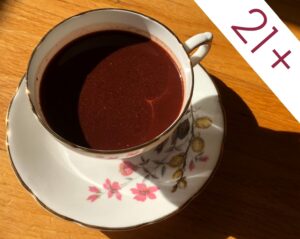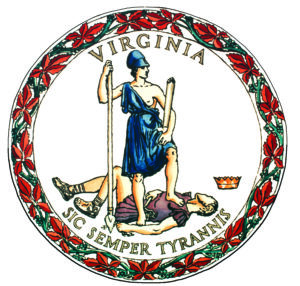Duration: 20-30 minutes
Recommended Ages: Kids 8+ with adult supervision for chocolate. Adults 21+ for chocolate wine recipe.
Description: Use ingredients you have at home to make delicious hot chocolate recipes from the 18th century.
Colonial Cooking
Chocolate has a fascinating history. As Spanish explorers plundered Central and South America, they learned about local foods, including cacao. Though they first found it bitter, they soon discovered that when they added sugar and spices that suited their flavor palate, they could create a beverage more to their taste. Starting in the early 16th century, they took cacao back to Europe and started selling this refined chocolate to other European countries. By the 18th century, English colonists brought chocolate back to the New World; they often drank it with their breakfasts. This beverage likely graced the table at Gunston Hall during George Mason’s lifetime.
When it was first introduced in Europe, doctors thought that chocolate was “a good medicine; at least a diet, for keeping up the warmth of the stomach;” an idea which didn’t fade through much of the 18th century. During the French and Indian War in the 1750s Benjamin Franklin procured supplies for the British Army, and one of the goods he managed to secure was chocolate.
Colonists continued to believe that chocolate drinks helped keep people strong. In fact, chocolate appears in many records from the American Revolution. For example, the general orders of the Massachusetts provincial congress in 1775 mandated that once a week every company of soldiers should receive “6 pounds of chocolate.” The Virginia General Assembly passed a resolution in 1778 to immediately pay officers and soldiers for six months and furnish them with “a variety of Articles which by Custom and habit are become Almost the Necessaries of Life.” These necessities included “chocolate at half a Dollar per pound.”
Even George Washington’s surviving papers from the Revolution show how much he valued chocolate. Washington spent much of the war trying to get supplies–including chocolate–for his poorly outfitted army. He sought chocolate for his own consumption and for his soldiers’ use. In 1780, a committee of the Continental Congress assigned to confer with Washington about the state of supplies for the army noted that
“We have omitted observing that the Medical department are destitute of those necessaries, which are indispensable for the sick. They have neither wine, Tea, sugar, Coffee, Chocolate, or spirits. We wish orders may be given for an immediate supply, as the army grow more sickly every hour.”
George Mason, like Washington and many others, provided goods to the army during the American Revolution. The few remaining records indicate that Mason found bacon and salt for the army. Perhaps he also procured chocolate for the military.

By the Revolution, drinking chocolate usually contained pure cacao, sugar, and, when available, milk. It included a blend of healthy fats, sugar, and protein in a liquid form. People believed it to be easily consumed and digested by those otherwise unable to eat. Many recipes for chocolate, including the one below for chocolate wine, also included alcohol. Brandy frequently makes an appearance in boozy chocolate recipes, along with Port and sherry. The chocolate recipes below, whether you choose kid-safe or adults-only, produce a delectable treat: a thick, velvety drinking chocolate. Feel free to spice the chocolate with cinnamon, clove, nutmeg, and even chili pepper, all common in 18th-century chocolate. Serve it after dinner with a dollop of whipped cream for an extra special treat.

Chocolate
Many people boil chocolate in a coffee pot; but I think it better to boil it in a skillet or something open. A piece of chocolate as big as a dollar is the usual quantity for a quart of water; but some put in more, some put in less. When it boils put in as much milk as you like and let them boil together three or four minutes. It is much richer with the milk boiled in it. Put the sugar in either before or after, as you please. Nutmeg improves it. The chocolate should be scraped fine before it is put into the water.
Child, Lydia Maria. The Frugal American Housewife, 1833.
Notes: The size of a dollar coin in this time was approximately 1.5 inches, probably about ¼ cup. This ratio results in a thin, milky hot chocolate, akin to warm chocolate milk. Other recipes like the one for chocolate wine below, recommend a ratio of 4 ounces (or ¾ cup of chocolate) to a pint or quart of liquid, creating a much thicker and more luscious chocolate drink. Our adaptation of this recipe is somewhere in between. It makes four servings.
Recipe Adaptation
Servings: 4 x 8 oz hot chocolates
Cook Time: 15 minutes
½ c. unsweetened bakers chocolate (chopped) or chocolate chips
½ c. sugar (omit, or cut to ¼ c. if using chocolate chips)
Water, enough to cover the chocolate
3-½ c. milk use whatever milk you have at home. In the 18th century, milk was similar to our whole milk, but this recipe works well with 2% and fat free milk, as well as with almond or coconut milk.
Nutmeg
1. Put your chocolate in a small saucepan over low to medium-low heat. Just cover the chocolate with water, about ½ c. Stir occasionally as the chocolate melts, and work to combine the chocolate and water into a smooth mixture. Melt the chocolate very carefully to keep from scorching it. Scorched chocolate tastes off and will not mix with the milk. If you have a double boiler, you may wish to use that to further prevent burning.
2. You may see little chunks of chocolate in your liquid even after stirring. Heat the mixture a little longer and stir vigorously again, until the chocolate melts completely.
3. Slowly pour in your milk, stirring as you add it. You may be able to see more particles of chocolate in your pan. That’s okay. Repeat step two until the mixture is smooth. Add the sugar and stir until dissolved.
4. Allow the mixture to cook on low heat, bringing it to simmer but not boil. Stirring occasionally, continue heating for 5 minutes or until somewhat thickened.
5. Pour your chocolate into mugs, and top with grated nutmeg if desired. Serve immediately.

To make Wine Chocolate
Take a pint of Sherry, or a pint and a half of red Port, four Ounces and a half of Chocolate, six Ounces of fine Sugar, and half an Ounce of white Starch or fine Flour; mix, dissolve, and boil these all together as before. But if your Chocolate be with Sugar, take double the Quantity of Chocolate, and half the Quantity of Sugar; and so in all.
Nott, John. The Cooks and Confectioners Dictionary, 1723.
Note: John Nott refers to a previous recipe when he uses the words “as before.” He is indicating that the cook should dissolve all the ingredients together and boil them, and that the chocolate “will be done in ten or twelve Minutes.”
Recipe Adaptation:
Servings: 4x 4oz glasses
Cook Time 15-20 minutes
1 c. Sherry or 1-½ c. red Port
¼ c. + 2 tbsp unsweetened bakers chocolate or ¾ c chocolate chips
¼ c. + 2 tbsp sugar (omit or cut to 3 Tbsp for chocolate chips)
1-½ tbsp. flour (You may substitute 1 Tbsp of cornstarch or rice flour. Arrowroot is not a good choice for this recipe.)
1. Add the chocolate to a small saucepan over low heat. Melt the chocolate carefully, adding a small amount of the sherry or port to prevent scorching if necessary. If you have a double boiler, you may wish to use that as an extra insurance against burning.
2. Once the chocolate is completely melted, add the sugar, and stir until dissolved.
3. Add ¾ cup of your sherry or Port to the chocolate, and stir until combined.
4. Whisk together the remaining sherry or Port with the flour until they are completely combined. This technique helps prevent clumps of uncooked flour in the final beverage. Add this mixture, or slurry, to the saucepan and cook, stirring frequently, until the mixture has thickened. The chocolate should take about 10 minutes to thicken.
5. Give the mixture a final whisking to ensure all of the ingredients are fully combined. Serve warm or at room temperature.









